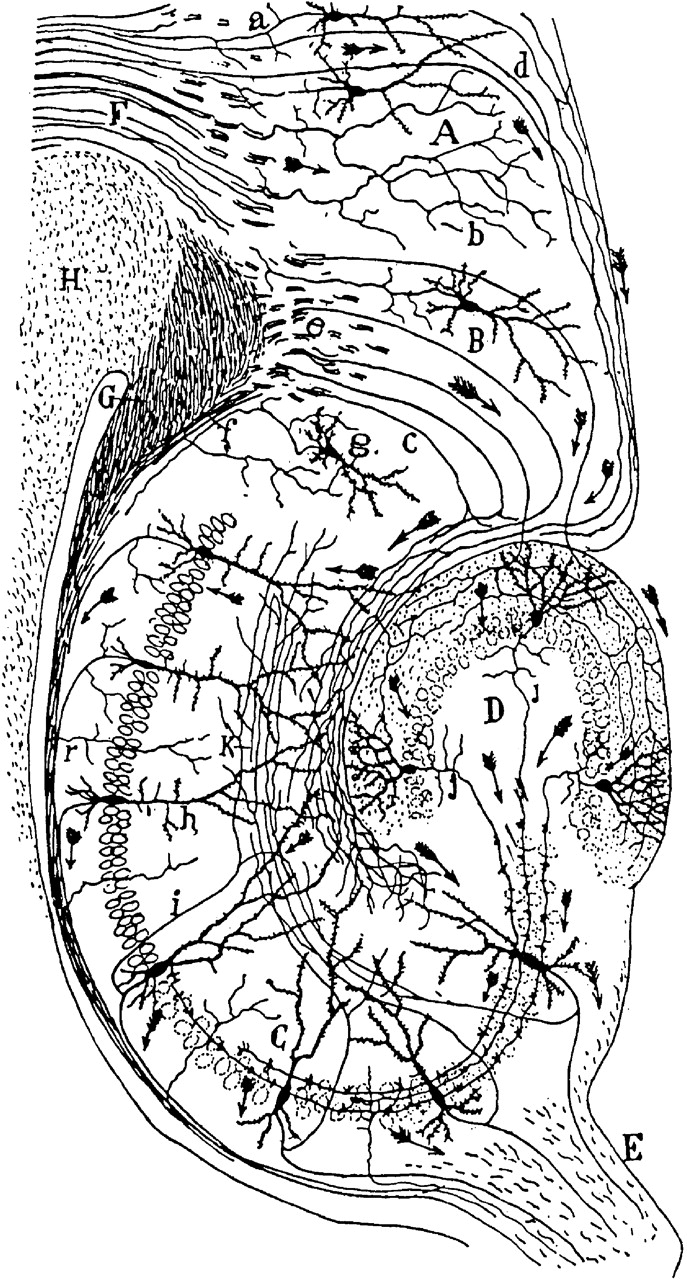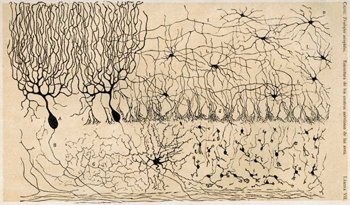Santiago Ramón y Cajal
Overview
Santiago Ramón y Cajal (May 1, 1852 – October 17, 1934) was a Spanish histologist, physician, and Nobel laureate. He is considered to be one of the founders of neuroscience.
Biography
The son of Justo Ramón and Antonia Cajal, Ramón y Cajal was born of Aragonese parents in Petilla de Aragón in Navarra, Spain. As a child he was transferred between many different schools because of his poor behaviour and anti-authoritarian attitude. An extreme example of his precociousness and rebelliousness is his imprisonment at the age of eleven for destroying the town gate with a homemade cannon. He was an avid painter, artist, and gymnast. He worked for a time as a shoemaker and barber, and was well known for his pugnacious attitude.
Ramón y Cajal attended the medical school of Zaragoza, from which he graduated in 1873. After a competitive examination, he served as a medical officer in the Spanish Army. He took part in an expedition to Cuba in 1874-75, where he contracted malaria and tuberculosis. After returning to Spain he married Silveria Fañanás García in 1879, with whom he had four daughters and three sons. He was appointed as a university professor at Valencia in 1881, and in 1883 he received his medical degree in Madrid. He later held professorships in both Barcelona and Madrid. He was Director of the Zaragoza Museum (1879), Director of the National Institute of Hygiene (1899), and founder of the [Laboratorio de Investigaciones Biológicas] error: {{lang}}: text has italic markup (help) (1922) (later renamed to the [Instituto Cajal] error: {{lang}}: text has italic markup (help), or Cajal Institute). He died in Madrid in 1934.
Works and theories
Ramón y Cajal's most famous studies were on the fine structure of the central nervous system. Cajal used a histological staining technique developed by his contemporary Camillo Golgi. Golgi found that by treating brain tissue with a silver chromate solution, a relatively small number of neurons in the brain were darkly stained. This allowed Golgi to resolve in detail the structure of individual neurons and led him to conclude that nervous tissue was a continuous reticulum (or web) of interconnected cells much like those in the circulatory system.
Using Golgi's method, Ramón y Cajal reached a very different conclusion. He postulated that the nervous system is made up of billions of separate neurons and that these cells are "dynamically polarized", i.e., they receive information at their cell bodies and dendrites, and transmit it unidirectionally towards other sites via their axons. Rather than forming a continuous web, Cajal suggested that neurons communicate with each other via specialized junctions called synapses, a term that was coined by Sherrington in 1897. This hypothesis became the basis of the neuron doctrine, which states that the individual unit of the nervous system is a single neuron. Electron microscopy later showed that a plasma membrane completely enclosed each neuron, supporting Cajal's theory, and weakening Golgi's reticular theory.
However, with the discovery of electrical synapses (gap junctions: direct junctions between nerve cells), some have argued that Golgi was at least partially correct. For this work Ramón y Cajal and Golgi shared the Nobel Prize in Physiology or Medicine in 1906.
Ramón y Cajal also proposed that the way axons grow is via a growth cone at their ends. He understood that neural cells could sense chemical signals that indicated a direction for growth, a process called chemotaxis.
Distinctions and books
Among his many distinctions and societal memberships, Ramón y Cajal was also made an honorary Doctor of Medicine of the Universities of Cambridge and Würzburg and honorary Doctor of Philosophy of the Clark University.
He published over 100 scientific works and articles in French, Spanish, and German. Among his most notable were Rules and advices on scientific investigation, Histology, Degeneration and regeneration of the nervous system, Manual of normal histology and micrographic technique, Elements of histology, Manual of general pathological anatomy, New ideas on the fine anatomy of the nerve centres, Textbook on the nervous system of man and the vertebrates, and The retina of vertebrates.
In 1905, he published five science-fictional "Vacation Stories" under the pen name "Dr. Bacteria."
The asteroid 117413 Ramonycajal is named in his honour.
Gallery of drawings by Santiago Ramón y Cajal
-
Drawing of the neural circuitry of the rodent hippocampus. Histologie du Systeme Nerveux de l'Homme et des Vertebretes, Vols. 1 and 2. A. Maloine. Paris. 1911.
-
Drawing of the cells of the chick cerebellum, from "Estructura de los centros nerviosos de las aves", Madrid, 1905.
-
From "Structure of the Mammalian Retina" Madrid, 1900.
-
Drawing of Purkinje cells (A) and granule cells (B) from pigeon cerebellum by Santiago Ramón y Cajal, 1899. Instituto Santiago Ramón y Cajal, Madrid, Spain.
See also
References
- Ramón y Cajal, Santiago (1937). [Recuerdos de mi Vida] error: {{lang}}: text has italic markup (help). Cambridge: MIT Press. ISBN 8420622907.
- Ramón y Cajal, Santiago (1999) [1897]. Advice for a Young Investigator. translated by Neely Swanson and Larry W. Swanson. Cambridge: MIT Press. ISBN 0262681501.
- Everdell, William R. (1998). The First Moderns. Chicago: University of Chicago Press. ISBN 0226224805.
External links
- The Nobel Prize in Physiology or Medicine 1906
- Life and discoveries of Cajal
- Ramon y Cajal, an Aragonese Nobel Prize
- Special Collection: Santiago Ramón y Cajal (University of Barcelona Library)
- Brief overview of Cajal's career
Template:Nobel Prize in Physiology or Medicine Laureates 1901-1925



